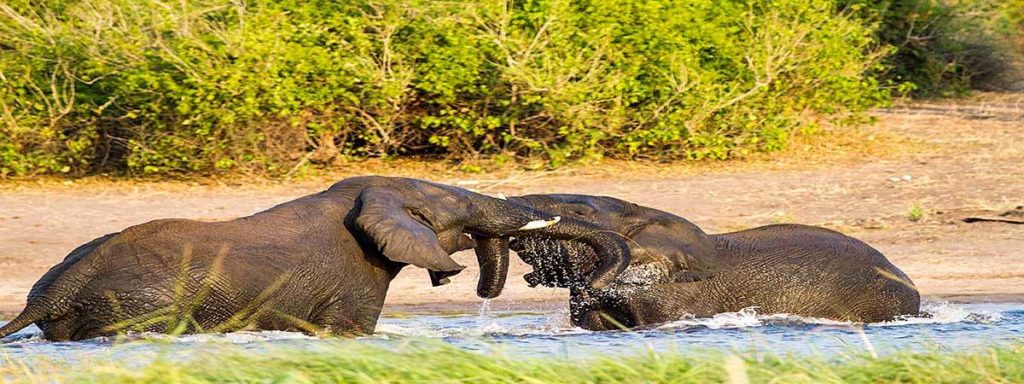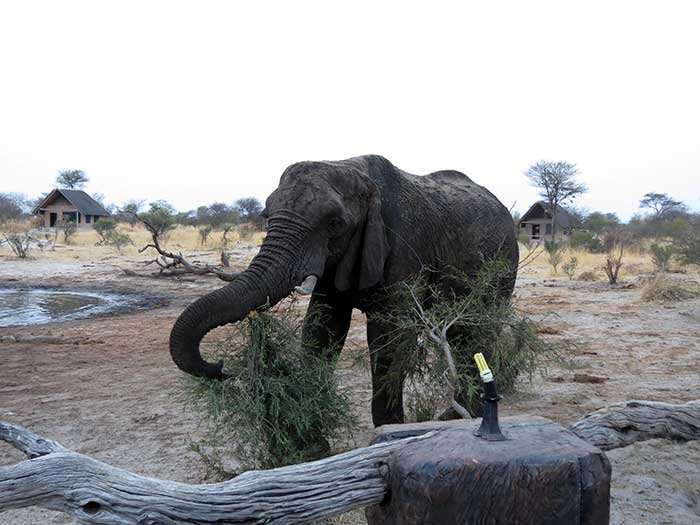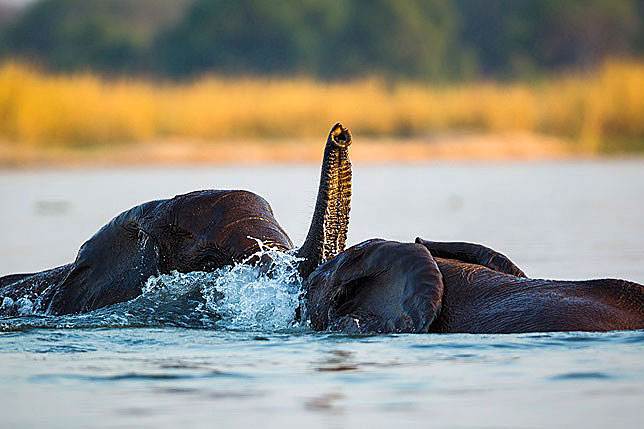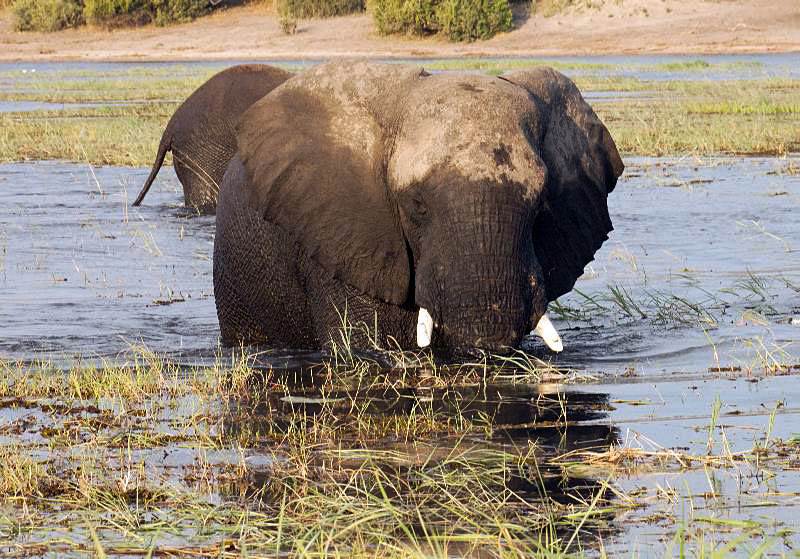Elephants (loxodonta africana) Facts & Information
Elephants facts and information gives you all you need to know about Africa’s gentle giants.
Member of that elite order called the Big 5, your sure to find elephants in all of the southern African countries.
As the largest land animal, look at an elephant’s ear and compare it to a map of Africa. Notice the similarity.
Watch an elephant herd near water – they will drink, bathe, swim, roll around; all part of their love affair with water. After the beathing ritual comes the mud bath, after which the sand bath and then every so slowly they move on to forage.

Elephant physical description
Mass –from 5000 to 6300kg (male) from 2800 – 3500kg (female)
Shoulder Height – 3.2 to 4 metres (male) 2.5 to 3.4 metres (female)
Tusks
Are greatly elongated incisors (elephants have no canine teeth); about one-third of their total length lies hidden inside the skull. The largest tusk ever recorded weighed 214 pounds and was 138 inches long.
Tusks of this size are not found on elephants in Africa today, as over the years hunters and poachers have taken animals with the largest tusks.
Because tusk size is an inherited characteristic, it is rare to find one now that would weigh more than 100 pounds


Trunks
Of all its specialized features, the muscular trunk is the most remarkable it serves as a nose, a hand, an extra foot, a signaling device and a tool for gathering food, siphoning water, dusting, digging and a variety of other functions. Not only does the long trunk permit the elephant to reach as high as 23 feet, but it can also perform movements as delicate as picking berries or caressing a companion.
The Elephant’s trunk is very sensitive and can even detect water under ground. There are as many as 50 000 muscles in an elephant’s trunk. The sensitive finger-like appendages at the tip of the trunk enables them to pick the smallest twig or flower. Their tusks are actually their upper incisors, and grow continuously until they die at around 60 years old.
Although their skin is up to 3cm (1 inch) thick, it is quite sensitive. An elephants hearing and smell are excellent but eyesight is moderate and best in dim light. Elephants lack sweat glands, so they use their large ears (up to 2 meters) for cooling.
The elephant’s trunk is 2 meters long and can weigh 130 kg The trunk has 40,000 to 100,000 muscles and can hold 6 liters of water which it can squirt into its mouth for drinking or use for bathing
The African elephant is larger than the Asian elephant, and it has bigger ears. Its color is lighter, and it has two prehensile “fingers” at the tip of its trunk whereas the Asian elephant only has one
Breeding
African elephants are not seasonal breeders. Generally they produce one calf every three to four years. The gestation period is about 22 months. At birth calves weigh about 100 kg and are fully weaned between 18-24 months.
An orphaned calf will usually be adopted by one of the family’s lactating females or suckled by various females. Elephants are very attentive mothers, and because most elephant behavior has to be learned, they keep their offspring with them for many years. Tusks erupt at 16 months but do not show externally until 30 months. Once weaned, usually at age 4 or 5, the calf still remains in the maternal group.
At birth, an elephant calf weighs 118kg and is able to walk under its mothers belly for the first year. Elephants spend 16-18 hours a day grazing and browsing, from ground level to 18 feet or more into trees, when standing on their hind legs and stretching out their long trunks. They also use their trunks to squirt water into their mouths at seven litres a sip! In a full drinking session elephants take up to 50 litres of water

The flapping action of their ears when charging is thought to be merely a cooling action as the stress of the moment causes them to become overheated. The advantage of this is that it helps them to look even more fearsome to their enemies.
Elephants are unfortunately very destructive feeders. Often large trees are pushed over and only a few leaves eaten from the top. If too many are confined to a small area, massive damage and deforestation can and does indeed occur

Behaviour
Mature males form bachelor groups or become solitary bulls. Elephants form strong family units of cows, calves and young offspring. Such herds are always led by an old female. Apart from drinking large quantities of water they also love wading or swimming in it. Elephants clearly relish mud baths.
It was once thought that family groups were led by old bull elephants, but these males are most often solitary. The female family groups are often visited by mature males checking for females in oestrus. Several interrelated family groups may inhabit an area and know each other well.
Females mature at about 11 years and stay in the group, while the males, which mature between 12 and 15, are usually expelled from the maternal herd. Even though these young males are sexually mature, they do not breed until they are in their mid, or late 20s or even older and have moved up in the social hierarchy.
The flapping action of their ears when charging is thought to be merely a cooling action as the stress of the moment causes them to become overheated. The advantage of this is that it helps them to look even more fearsome to their enemies. Elephants are unfortunately very destructive feeders and often large trees are pushed over and only a few leaves eaten from the top. If too many are confined to a small area, massive damage and deforestation can and does indeed occur
Family Life
Elephants are generally gregarious and form small family groups consisting of an older matriarch and three or four female offspring, along with their young.
The female family groups are often visited by mature males checking for females in estrus. Several interrelated family groups may inhabit an area and know each other well. When they meet at watering holes and feeding places, they greet each other affectionately.
Smell is the most highly developed sense, but sound deep growling or rumbling noises is the principle means of communication. Some researchers think that each individual has its signature growl by which it can be distinguished. Sometimes elephants communicate with an ear-splitting blast when in danger or alarmed, causing others to form a protective circle around the younger members of the family group. Elephants make low-frequency calls, many of which, though loud, are too low for humans to hear. These sounds allow elephants to communicate with one another at distances of seven kms
Elephants are voracious feeders which in a day consume up to 272 Kg of grass, tender shoots and bark from trees. An adult Elephant can drink up to 200 litres of water in a single session. A single elephant deposits upwards of 150kg of dung every day – about one dollop every 15 minutes!
